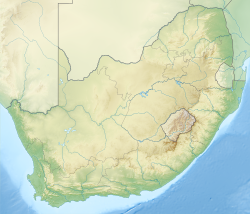| Sand River Sandrivier | |
|---|---|
 Sand River (middle right) on a map of 1887 | |
| Etymology | Named after an incident in which a wagon got stuck into the sand of its dry riverbed [1] |
| Location | |
| Country | South Africa |
| State | Free State |
| Physical characteristics | |
| Source | By Tweefontein |
| • location | NW of Ficksburg |
| • elevation | 1,660 m (5,450 ft) |
| Mouth | Vet River |
• location | Near Tierfontein |
• coordinates | 28°5′33″S26°24′51″E / 28.09250°S 26.41417°E |
• elevation | 1,260 m (4,130 ft) |
| Length | 200 km (120 mi) |
The Sand River (Afrikaans : Sandrivier, formerly Zandrivier [2] ) is a river in the Free State province, South Africa. It is located close to the towns of Welkom and Virginia in the gold mining centre of the Free State. Its source is located close to Tweefontein NW of Ficksburg not far from the South Africa-Lesotho border (at 28°40′49″S27°41′23″E / 28.68028°S 27.68972°E ). This river is famous because of the historical Sand River Convention signed nearby, an important event in South African political history.
